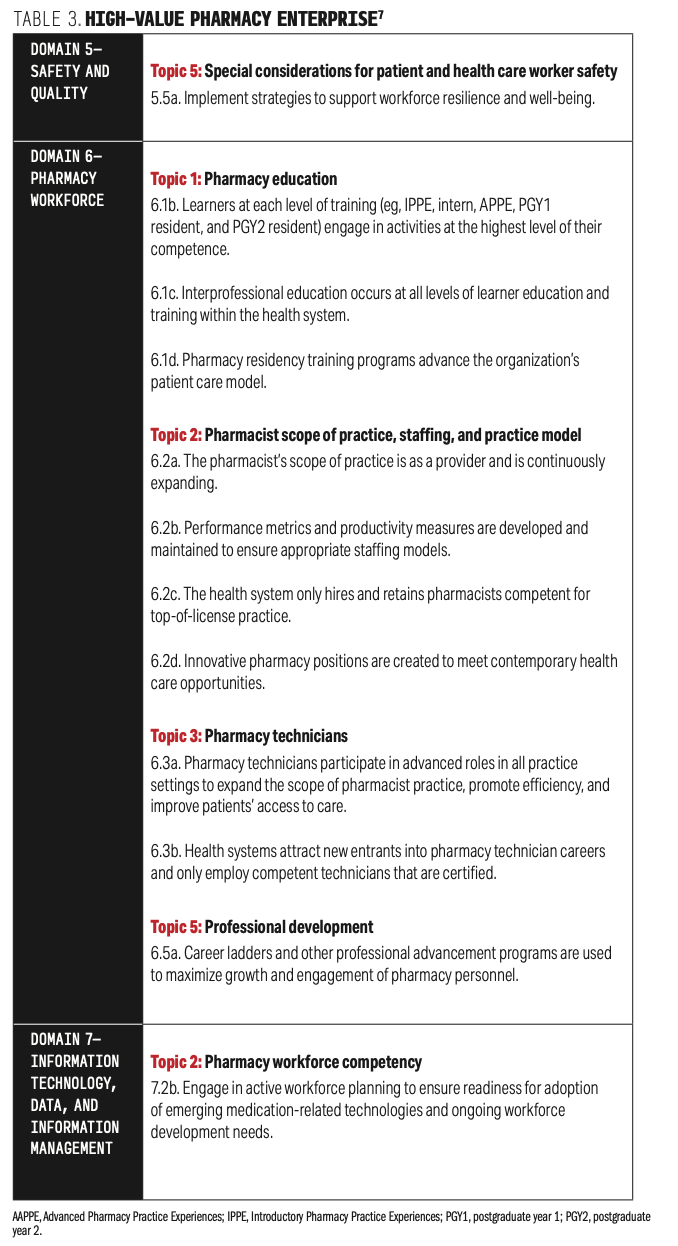Workforce Challenges for Health System Pharmacy
The COVID-19 pandemic has exposed the cracks in health system pharmacy. Here’s how the workforce can adapt.
The past 2 years have been quite the roller-coaster ride for health care. Although workforce challenges existed previously, the COVID-19 pandemic has shined a spotlight on health systems labor and workforce needs and the critical role of pharmacy in the care team.
Challenges
Let’s start with the elephant in the room: How has the pandemic impacted health system pharmacy workforces? There is no doubt the pandemic has stressed the nation’s workforces, but health care workers have felt the brunt of that stress. The volume of patients being cared for has changed drastically. Cancelled procedures and avoidance of care have led to layoffs and furloughs, whereas surge periods have led to an influx of higher acuity patients, requiring treatment in new locations, filling of ambulatory care gaps, and pulling out all stops for additional staff.
New or expanded services have also led to pharmacy-focused efforts to support new treatments, vaccinations, prophylaxis, and changing sites of care to telehealth and home infusion. Overall, this was positive, reflecting the importance of pharmacy. However, drug shortages and recalls, compounded during the pandemic, only added insult to injury. This was positive overall and reflects the importance of pharmacy. That drug shortages and recalls were compounded during the pandemic added insult to injury.
The result of these challenges is a negative impact on the mental health and well-being of the workforce, leading to higher levels of burnout. This, plus the additional dynamics of the pandemic, has resulted in increased resignations. Although specific figures are not available for pharmacy, the American Hospital Association reported that job postings for allied clinical staff have increased by 41% between January 2020 and January 2022.1
Recruitment and retention are top concerns for health system pharmacy leaders, with technician staff short- ages representing the biggest concern. This is a multifaceted problem that goes well beyond burnout that will require a multipronged approach.2
Additional challenges not related to the pandemic include the pharmacy enterprise scope, workforce skill mix, and pharmacy labor metrics. The pharmacy enterprise describes the broad scope of health system pharmacy services, ranging from acute critical care to ambulatory clinics to outpatient and specialty pharmacies, home infusion, and beyond. This diverse scope requires a diverse work- force that can adapt to advances in care and technology.
Despite this diverse workload, pharmacy departments are often held to single labor metrics related to doses dispensed, which is a metric that is not reflective of the diverse and complex work of the enterprise. As pharmacy leaders, it is critical that we know our business and labor needs so we can advocate for the appropriate roles and resources and ensure we are providing safe and efficient patient care, achieving quality and financial goals, and supporting the safety and well-being of our pharmacy teams.
Capacity Analysis
Is your department the right size? Assessing key areas, such as workload and acuity metrics, labor metrics, and benchmarks, are necessary to deter- mine whether we have the right number and skill mix in our workforce. Research published in the American Journal of Health-System Pharmacy3 provided specific examples of these metrics from a recent capacity analysis at an academic medical center (Table 1).3
Table 1. Metrics

Some of these metrics are overlooked as the workforce is assessed, which can cause strain and reduce engagement. Other organizations, such as the American Nurses Credentialing Center Magnet Recognition Program, have exemplary models for supporting training and professional development. By looking to these organizations, health systems leadership can ensure there is budget for training days, annual competencies, new technologies, and professional development to prevent gaps.
Strategic Wisdom
The health system pharmacy workforce has been a priority topic in several recent publications for the American Society of Health-System Pharmacists (ASHP) Foundation Pharmacy Forecasts4-6 and the high-value pharmacy enterprise framework.7 In addition, the newly formed Health System Strategy Council of the American Pharmacists Association will also address workforce challenges. Table 2 and Table 34-6 include excerpts of the recommendations related to workforce. These key concepts can be used as a checklist to evaluate whether health systems leadership have imple- mented these recommendations.
Table 2. ASHP Foundation Pharmacy Forecase Highlights, 2020-2022

The pandemic has highlighted cracks in our health system pharmacy workforce that can be addressed with systematic capacity analysis, justifica- tion of resources, and implementation of strong workforce engagement and development plans.
Table 3. High-Value Pharmacy Enterprise

References
- Data brief: workforce issues remain at the forefront of pandemic-related challenges for hospitals. American Hospital Association. January 24 2022. Accessed February 15, 2022. https://www.aha.org/issue-brief/2022-01-25-data-brief-workforce-issues-remain-forefront-pandemic-related-challenges
- 2022 AHA health care talent scan. American Hospital Association. Accessed February 15, 2022. https://www.aha.org/aha-talent-scan
- Vaeth S, Zaniewski A, Polat N, et al. Justification of nearly 50 staff members through robust metrics and capacity analysis at an academic medical center. Am J Health Syst Pharm. 2021;78(17):1603-1626. doi:10.1093/ajhp/zxab299
- Vermeulen LC, Swarthout MD, Alexander GC, et al. ASHP Foundation Pharmacy Forecast 2020: strategic planning advice for pharmacy departments in hospitals and health systems. Am J Health Syst Pharm. 2020;77(2):84-112. doi:10.1093/ajhp/zxz283
- DiPiro JT, Fox ER, Kesselheim AS, et al. ASHP Foundation Pharmacy Forecast 2021: strategic planning advice for pharmacy departments in hospitals and health systems. Am J Health Syst Pharm.2021;78(6):472-497. doi:10.1093/ajhp/zxaa429
- DiPiro JT, Carmichael JM, Johnson VB, et al. ASHP Foundation Pharmacy Forecast 2022: strategic planning guidance for pharmacy departments in hospitals and health systems. Am J Health Syst Pharm. 2022;79(2):23-51. doi:10.1093/ajph/zxab355
- Rough S, Shane R, Armitstead JA, et al. The high-value pharmacy enterprise framework: advancing pharmacy practice in health systems through a consensus-based, strategic approach. Am J Health Syst Pharm.2021;78(6):498-510. doi:10.1093/ajhp/zxaa431

Psychiatric Pharmacist Working to Optimize Treatment, Improve Patient Safety
December 13th 2024A conversation with Nina Vadiei, PharmD, BCPP, clinical associate professor in the Division of Pharmacotherapy at University of Texas at Austin College of Pharmacy and a clinical pharmacy specialist in psychiatry at the San Antonio State Hospital.